2012年07月22日
.50 BMGs Battle
私たちのブログを訪問していただきありがとうございます。あなたがお持ちの場合DIYの要求は私達に電子メールを送信してください。
Air Force snipers help TW find the big bore that packs all the right punch!
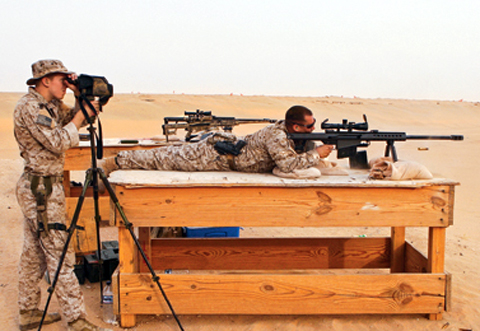
Barrett’s M107 operating system allows the rifle to function reliably in the harshest environments. U.S. Marine Corps Sgt. Daniel Price, left, a team leader with 3rd Platoon, Alpha Company, 1st Marine Reconnaissance Battalion, 13th Marine Expeditionary Unit, spots impacts down range for Gunnery Sgt. David Lind, a platoon sergeant with 3rd Platoon, Alpha Company, 1st Marine Reconnaissance Battalion, 13th Marine Expeditionary Unit, while he zeros his .50-caliber M107 special applications scoped rifle from an unknown distance on Udari range, Kuwait. (U.S. Marine Corps photo by Lance Cpl. Kyle J. Keathley) (Released)
Bushmaster BA50
Bushmaster entered into the .50 BMG realm a few years ago by offering the BA50. Just like every precision bolt-action .50 BMG rifle on the market, the BA50 is built to tolerances and specifications that allow sub-MOA capabilities. Its overall length is 58 inches, and the rifle weighs in at 33 pounds with a 30-inch Lothar Walther barrel and 10-round magazine. The muzzle velocity averages 2,945 FPS with standard military M33 ball ammunition with 661-grain projectiles, and the rifle comes with a full-length Picatinny rail that runs the entire length of the forearm to accommodate night optics. Assembly of the BA50 is one of the simplest on the market for dedicated bolt-action .50 BMG rifles. Similar to the AR design, the upper receiver locks on to the lower receiver with two pins integral to the lower receiver.
The BA50 is hammer-fired, similar to the AR design, easing maintenance and aiding in reliability. Accuracy relies heavily on locking consistency and support of the cartridge and projectile. Tighter tolerances in the chamber area allow for a more consistent expansion of the cartridge as the powders ignite. The BA50 allows for a higher accuracy standard with a more modular chassis.
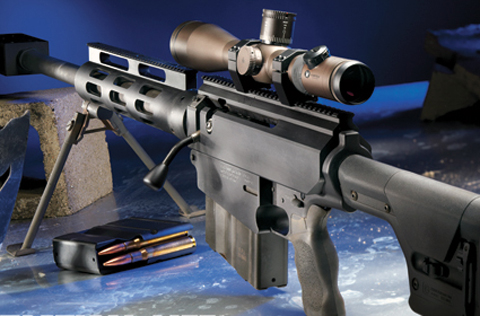
With high-quality glass mounted on Bushmaster’s .50-caliber beast, it’s a machine ready for anti-materiel and EOD disposal missions.
Barrett’s .50 BMG
Currently, the only mainstream, widely used semi-automatic, shoulder-fired .50 BMG rifle is the Barrett M82A1/M107. The weapon system functions via a short recoil operating system, similar to the Browning M2 machine gun chambered in the same cartridge. This creates an excessive amount of movement in the rifle, lowering the accuracy expectations to 2.5 MOA (or larger depending on how the firing position is set up). But it does utilize a 10-round magazine, allowing for a higher rate of fire, and has been proven to be extremely reliable in rugged environments. Military units around the world run this rifle platform and it has been extremely effective on the battlefields of Afghanistan and Iraq.
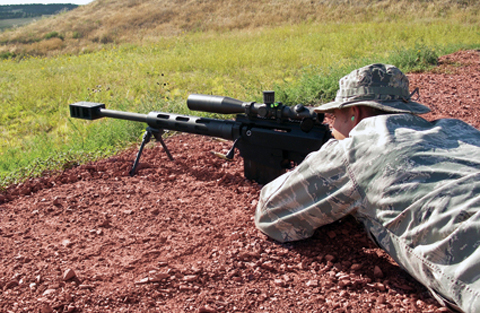
Designed for sub-MOA accuracy and with tight tolerances, the bolt-action Bushmaster BA50 is a very capable sniper rifle.
BLOG ARCHIVES

Air Force snipers help TW find the big bore that packs all the right punch!

Barrett’s M107 operating system allows the rifle to function reliably in the harshest environments. U.S. Marine Corps Sgt. Daniel Price, left, a team leader with 3rd Platoon, Alpha Company, 1st Marine Reconnaissance Battalion, 13th Marine Expeditionary Unit, spots impacts down range for Gunnery Sgt. David Lind, a platoon sergeant with 3rd Platoon, Alpha Company, 1st Marine Reconnaissance Battalion, 13th Marine Expeditionary Unit, while he zeros his .50-caliber M107 special applications scoped rifle from an unknown distance on Udari range, Kuwait. (U.S. Marine Corps photo by Lance Cpl. Kyle J. Keathley) (Released)
Bushmaster BA50
Bushmaster entered into the .50 BMG realm a few years ago by offering the BA50. Just like every precision bolt-action .50 BMG rifle on the market, the BA50 is built to tolerances and specifications that allow sub-MOA capabilities. Its overall length is 58 inches, and the rifle weighs in at 33 pounds with a 30-inch Lothar Walther barrel and 10-round magazine. The muzzle velocity averages 2,945 FPS with standard military M33 ball ammunition with 661-grain projectiles, and the rifle comes with a full-length Picatinny rail that runs the entire length of the forearm to accommodate night optics. Assembly of the BA50 is one of the simplest on the market for dedicated bolt-action .50 BMG rifles. Similar to the AR design, the upper receiver locks on to the lower receiver with two pins integral to the lower receiver.
The BA50 is hammer-fired, similar to the AR design, easing maintenance and aiding in reliability. Accuracy relies heavily on locking consistency and support of the cartridge and projectile. Tighter tolerances in the chamber area allow for a more consistent expansion of the cartridge as the powders ignite. The BA50 allows for a higher accuracy standard with a more modular chassis.

With high-quality glass mounted on Bushmaster’s .50-caliber beast, it’s a machine ready for anti-materiel and EOD disposal missions.
Barrett’s .50 BMG
Currently, the only mainstream, widely used semi-automatic, shoulder-fired .50 BMG rifle is the Barrett M82A1/M107. The weapon system functions via a short recoil operating system, similar to the Browning M2 machine gun chambered in the same cartridge. This creates an excessive amount of movement in the rifle, lowering the accuracy expectations to 2.5 MOA (or larger depending on how the firing position is set up). But it does utilize a 10-round magazine, allowing for a higher rate of fire, and has been proven to be extremely reliable in rugged environments. Military units around the world run this rifle platform and it has been extremely effective on the battlefields of Afghanistan and Iraq.

Designed for sub-MOA accuracy and with tight tolerances, the bolt-action Bushmaster BA50 is a very capable sniper rifle.
BLOG ARCHIVES

Posted by echigoyaworks
at 19:00
2012年07月22日
Dynamic Warriors
私たちのブログを訪問していただきありがとうございます。あなたがお持ちの場合DIYの要求は私達に電子メールを送信してください。
Run the gun and your mind through Magpul’s high-speed, low-drag carbine course with today’s top tactical operators!
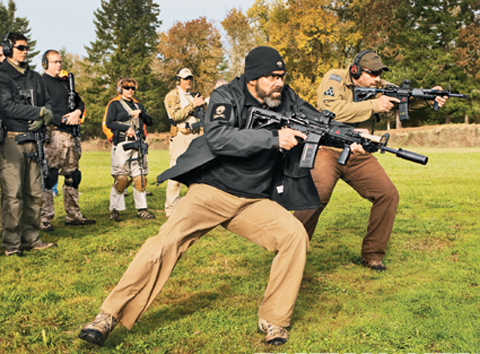
Little of the Magpul Dynamics course is standing on the flat range firing numbered shot counts. Students are taught to move, turn, problem solve and deliver accurate shots.
To check out the company that has sold more than 1.5 million polymer magazines and whose training division raised the bar on instructional videos with its Art of the Dynamic Carbine (1&2), Art of Dynamic Handgun and Aerial Platform Operations Series, TW stepped inside the Magpul Dynamics’ Dynamic Carbine Course in Hammond, LA to see if these guys are as good as their videos.
Dynamic Carbine 1: Building the Fundamentals
"We will give the students an honest snapshot of themselves, very quickly,” says Chris Costa, Magpul Dynamics Instructor. The Dynamic Carbine 1 course brought together shooters from across the country and throughout the range of shooting experience. There were several husband and wife attendees, a father and son, as well as law enforcement, hobbyists, and professional security contractors. After a detailed safety briefing, instructors Costa, Haley, and Olivella began building up the fundamentals in their students. Starting with basic body position, stance, and trigger control, the class moved to confirming zero on their optics. Once zeroed, in-depth work began on sight picture/sight alignment differences at ranges from 5 to 50 yards. Reload techniques such as speed (under fire), tactical (in action, but covered), and admin (no threat, get re-organized) were covered, as well as malfunction drills (double-feed, mag failure, mis-fire, stovepipe).
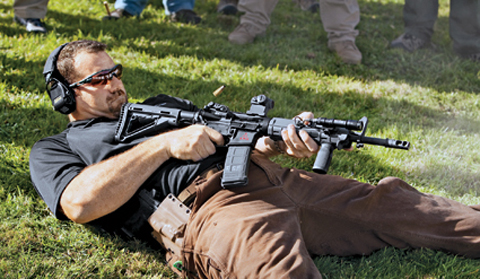
Instructor demonstrates the supine position. The position is a critical skill that allows shooter to tactically recover from a slip or dramatically reduce his profile while continuing to deliver well-aimed shots under fire.
As the course continued over the next three days, BSA drills (“Balance of Speed and Accuracy”) became a common element. The BSA drill measures timed rounds into an 8-inch center-mass circle on the man-sized Magpul targets. Students were encouraged to push their limits from standing, kneeling, and prone positions at varying distances. The targets told the tale: If the group was too tight with no hits outside the circle, speed was lacking. If the group was scattered outside the circle, the shooter should slow down and concentrate on body position and accuracy. This litmus test gave each student instant feedback at every drill as to how fast he/she could push the rifle and put combat-effective hits on the target.
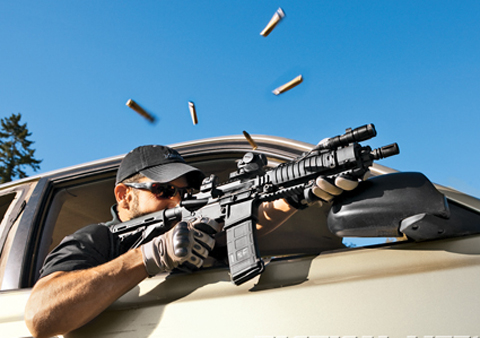
Magpul tests both decision making and weapons handling skills. Above, a student engages multiple targets from the open window of a vehicle.
On the afternoon of day two, the instructors conducted a “mini” handgun course. While the handgun is typically a class unto itself, the transition to the handgun in the event of a carbine malfunction at close range is a crucial skill and would become a part of many of our subsequent drills. Day three brought a significant increase in the pace of the drills, which now included weapons transitions, timed speed events, movement to multiple targets and barricade obstacle shooting. Dynamic Carbine 1 ended with shooters more confident, competent, and mindful than when they arrived.
BLOG ARCHIVES

Run the gun and your mind through Magpul’s high-speed, low-drag carbine course with today’s top tactical operators!

Little of the Magpul Dynamics course is standing on the flat range firing numbered shot counts. Students are taught to move, turn, problem solve and deliver accurate shots.
To check out the company that has sold more than 1.5 million polymer magazines and whose training division raised the bar on instructional videos with its Art of the Dynamic Carbine (1&2), Art of Dynamic Handgun and Aerial Platform Operations Series, TW stepped inside the Magpul Dynamics’ Dynamic Carbine Course in Hammond, LA to see if these guys are as good as their videos.
Dynamic Carbine 1: Building the Fundamentals
"We will give the students an honest snapshot of themselves, very quickly,” says Chris Costa, Magpul Dynamics Instructor. The Dynamic Carbine 1 course brought together shooters from across the country and throughout the range of shooting experience. There were several husband and wife attendees, a father and son, as well as law enforcement, hobbyists, and professional security contractors. After a detailed safety briefing, instructors Costa, Haley, and Olivella began building up the fundamentals in their students. Starting with basic body position, stance, and trigger control, the class moved to confirming zero on their optics. Once zeroed, in-depth work began on sight picture/sight alignment differences at ranges from 5 to 50 yards. Reload techniques such as speed (under fire), tactical (in action, but covered), and admin (no threat, get re-organized) were covered, as well as malfunction drills (double-feed, mag failure, mis-fire, stovepipe).

Instructor demonstrates the supine position. The position is a critical skill that allows shooter to tactically recover from a slip or dramatically reduce his profile while continuing to deliver well-aimed shots under fire.
As the course continued over the next three days, BSA drills (“Balance of Speed and Accuracy”) became a common element. The BSA drill measures timed rounds into an 8-inch center-mass circle on the man-sized Magpul targets. Students were encouraged to push their limits from standing, kneeling, and prone positions at varying distances. The targets told the tale: If the group was too tight with no hits outside the circle, speed was lacking. If the group was scattered outside the circle, the shooter should slow down and concentrate on body position and accuracy. This litmus test gave each student instant feedback at every drill as to how fast he/she could push the rifle and put combat-effective hits on the target.

Magpul tests both decision making and weapons handling skills. Above, a student engages multiple targets from the open window of a vehicle.
On the afternoon of day two, the instructors conducted a “mini” handgun course. While the handgun is typically a class unto itself, the transition to the handgun in the event of a carbine malfunction at close range is a crucial skill and would become a part of many of our subsequent drills. Day three brought a significant increase in the pace of the drills, which now included weapons transitions, timed speed events, movement to multiple targets and barricade obstacle shooting. Dynamic Carbine 1 ended with shooters more confident, competent, and mindful than when they arrived.
BLOG ARCHIVES

Posted by echigoyaworks
at 12:00

